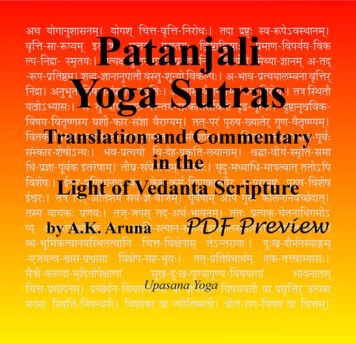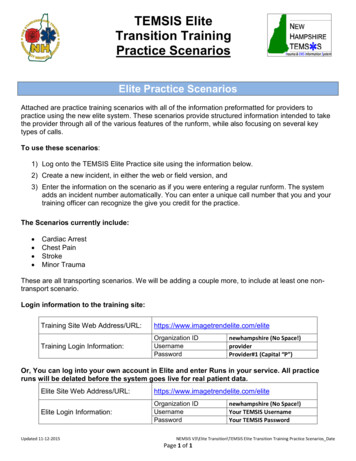
Transcription
(This Page Left Intentionally Blank)
PATANJALI YOGA SUTRASTranslation and Commentary in the Light ofVedanta Scriptureby A. K. ArunaPDF PreviewUpasana Yoga Media
Copyright 2013 by A. K. ArunaAll Rights ReservedThis free ebook preview may be copied, distributed, reposted, reprinted andshared, provided it appears in its entirety without alteration, and the reader isnot charged to access it.Please pass on this preview version of the Patanjali YogaSutras PDF, or the link from where you downloaded, toyour Yoga and Vedanta friends!Thank you, A.K Aruna (Alan Kellogg), author andpublisherISBN (PDF preview): 978-1-938597-10-7Edited by, and with contributions from, John WarnePublished byUpasana Yoga MediaPalm Desert, CAwww.UpasanaYoga.org
InvocationËË â Ë Ë ÍëËß Ë‚ Ë ºË Ë ’ËËëËË@ «Ë“@ ËÕÎÕ‚ Ë ëË ’Ëe Æ Ä Å Ë ËË { ºËËÄÅÕË Ë} Ë@ ºËœ’ ËÕ@ «ËÏ ËÎ ËË@ ºË ËõËó Í“@ ºËœË õËóÍ “ÕË Ë ËË { Í‚«ËGYogena cittasya padena vācāṃ malaṃ śarīrasya ca vaidyakenaYo'pākarot taṃ pravaraṃ munīnāṃ patañjaliṃ prāñjalir ānato'smiI bow with hands folded to Patañjali, the best of sages who removes the impurity ofthe mind by his Yoga[-sūtras], of speech by his words [his grammar commentarycalled Mahā-bhāṣya], and of the body by his science of medicine [calledCaraka-pratisaṃskṛta].
Other Titles by A.K. ArunaPatanjali Yoga Sutras: A Translation in the Light of Vedanta ScriptureThe Bhagavad Gita: Victory Over Grief And DeathThe Aruna Sanskrit Language SeriesThe Aruna Sanskrit Language Series is a groundbreaking series of media thatenriches the study of both the Sanskrit language and Vedanta. The six titlescurrently in the series are highly flexible and cross-referenced, guiding readersthrough Sanskrit basics to proficient level—unlocking the vocabulary andgrammar and helping them comprehend the deeper meaning of the BhagavadGita. These titles are available through the publishing arm of Upasana Yoga atwww.UpasanaYoga.org.The Titles in The Aruna Sanskrit Language SeriesThe Aruna Sanskrit Grammar ReferenceThe Aruna Sanskrit Grammar Coursebook: 64 Lessons Based on the BhagavadGita Chapter TwoThe Bhagavad Gita DictionaryThe Bhagavad Gita Reader: Sanskrit/English Parallel TextThe Bhagavad Gita Sanskrit Key: Verse-by-Verse Grammar & VocabularyThe Sanskrit Reading Tutor: Read It, Click It, Hear It!
ContentsPreface .Introduction .Patañjali’s Yoga SutrasChapter 1 On ContemplationIntroducing Yoga .General Definition of Yoga .The Goal of Yoga .What is the Essential Nature of Oneself .What is the Ego .How can Logic Help .How do I Know I am Simply the Witness .Life and Death .The 24/7 Reality .What is the Benefit .Patañjali Indicates This Witness Reality .Identification with Thought .The Nature of Thoughts .Repetition and Non-attachment .Two Forms of Contemplation .Contemplation on the Lord .The Nature of the Lord .Consciousness .1115232731323335394042454647496268747683
ContentsChapter 1 On Contemplation (continued)Distractions of the Mind .The Removal of Distractions .Clarity of Mind .Four Forms of Contemplation With Seed .Clarity and Knowledge .Contemplation Free of Seed .Chapter 2 On PreparationYoga in Regard to Action .The Five Afflictions .The Affliction of Ignorance .The Affliction of I-notion .The Afflictions of Attachment and Aversion .The Affliction of Fear of Death .Giving Up Afflictions .Karma-Storage From the Afflictions .Giving Up Sorrow .Mutual Identification of Seer and Seen .The Nature of the Seen .The Nature of the Seer .The Seen’s Relation to the Seer .Cause and Removal of Mutual Identification .The Eight Limbs of Yoga 51152161167
ContentsChapter 2 On Preparation (continued)The 1st Limb: Avoidances .The 2nd Limb: Observances .Nurturing the Avoidances and Observances .The Components of the Avoidances .The Components of the Observances .rdThe 3 Limb: Sitting Posture .The 4th Limb: Controlling of Breath .The 5th Limb: Withdrawal of the Senses .Chapter 3 On Accomplishments .The 6th Limb: Restraining Thoughts .The Contemplation Process .thThe 7 Limb: Retaining Thoughts .The 8th Limb: Contemplation .Uniting (Saṃyama) of the Last Three Limbs .Which are the Internal Limbs of Yoga? .Change Within Contemplation .Change Regarding All Objects .Accomplishments and Superpowers – Siddhis .Saṃyama on Change .Saṃyamas on the Seen and on the Seer .The Final Accomplishment is Freedom .Liberating Knowledge – Kaivalya 14218221224278297
ContentsChapter 4 On FreedomCauses of the Accomplishments .Action and the Mind .The Past and Future and the Present .Oneness Determines Entities .Contemplations from Science .Distinction of Objects and Thoughts .Distinction of Thoughts and Self .Knowledge as Freedom .AppendixesA. Yoga Sutra Text .B. Sanskrit of Footnote Quotations .C. Reverse Index of Text to Footnotes .D. The Nature of the Mind .E. Patañjali’s Five Stages of Contemplation .F. Suggested Steps in Contemplation .G. Suggested Sutra Selections for Courses .H. Pronunciation Key for Sanskrit TransliterationCharactersBibliography .Index .About the Author 948195
PrefaceYoga has been practiced for thousands of years by Indian spiritual seekers and saints.Yet, let us ask: Is there a single yoga text that specifically points out what thoseseekers and saints were actually contemplating in their yoga spiritual practice?Most modern yoga texts, in English, are about āsanas—postures for physicalstrengthening, relaxation, stretching, and physical therapy. A few also highlight thebenefits of these āsanas for relieving stress. Some introduce a little meditation,bringing in some spiritual words, such as love, bliss, and divine. Some present anāsana practice that includes a life of yoga off the mat. They may explain thesespiritual ideas and life styles with a few examples. There is often not enough depthunfoldment of these ideas and their expressions into a life style. Sometimes theyencourage the readers to imagine their own explanations—as if the seekers alreadyknow the answers they are seeking.These texts do not fluently connect the student to the contemplative spiritualscriptures of India, for which India is so well known. In this way, these yoga texts areunlikely to bring the student to a clear sense of a broad, integrated, in-depth spiritualgrounding that a full yoga encompasses.There is one ancient yoga text, though, that is held to be the philosophical andcontemplative basis of yoga. That text is the Yoga Sūtras by Patañjali. Its study hascome to be called Rāja Yoga, meaning the Royal Yoga. It is a teaching of yogaappropriate for a king (rājan) learned in scripture yet not a renunciate, such as thattaught to King Janaka by Yājña-valkya in the Bṛhad-āraṇyaka Upaniṣad scripture andto Prince Arjuna by Lord Kṛṣṇa in the Bhagavad Gītā. We would think, then, that thecommentaries and literature surrounding the Yoga Sūtras would be steeped in thescriptures of India—but that is not the case.The earliest extant and most influential Sanskrit commentary (bhāṣya) is by a mannamed Vyāsa. He does not quote any scripture. Instead, he sprinkles in his11
Prefacecommentary a few quotes from certain sages, culled mostly from the Mahā-Bhārataepic. The innumerable English translations and commentaries of these sūtras appearto only convey the spirituality, or lack thereof, of their many and varied authors. Eventhe scriptural leaning versions, such as the one by Bangali Baba (The Yogasutra ofPatanjali: With the Commentary of Vyasa) and the one jointly by SwamiPrabhavananda and Christopher Isherwood (How to Know God: The Yoga Aphorismsof Patanjali), sparingly connect the sūtras to specific scriptures. The effort here is torectify this void.There is also the purpose here to directly connect the many students and teachers ofthe Indian scriptures to the vast yoga community, and the yoga practitioners andteachers to the spiritual community.Previously, the gulf between the two has been bridged only by the individualstudent or teacher on their own. Much of that effort has been through connecting afew of the topics in yoga to anecdotal stories of spiritual saints. Most of these storiesrevolve around the modern founders or practitioners of the teacher’s lineage. Thesestories are more of a devotee’s praise than a real grounding in a full yoga traditiondating back thousands of years.The effort here is to formally bridge these two communities in all their myriadlineages with a common language and understanding. This is done through mappingthe terminologies, sūtras (aphorisms), and topics of the Yoga Sūtras directly to thehighly revered scriptures of India—namely, the Upaniṣads and the Bhagavad Gītā.As such, this text is helpful both to spiritual students seeking expanded and specificguidance, and to various teachers researching technical tools to bridge the apparentgap between yoga and the Indian scriptures.Coming from the United States, a different culture from yoga’s flowering ground, Iwas carefully and artfully introduced to these scriptures in 1976 by Pujya SwamiDayananda Saraswati (born 1930-). In India, I lived in the teacher’s family (gurukula) with over sixty other students for two and a half years.12
PrefaceThe classes were five a day, six days a week. We studied Sanskrit; chanting;meditation; the Bhagavad Gītā with Śaṅkara’s commentary; several introductoryVedanta texts, such as Tattva-Bodha and Ātma-Bodha; the Upaniṣad scriptures Kena,Praśna, Īśāvāsya, Muṇḍaka, and portions of Chāndogya and Bṛhad-āraṇyaka; plusthe three Upaniṣads Kaṭha, Māṇḍūkya with Kārika, and Taittirīya complete withŚaṇkara’s commentaries. Finally, we studied the four initial Vedānta Sūtras withŚaṅkara’s commentary—called the Catur-Śruti. We each have continued to studythese and other texts as needed after our course. Many such long and short termcourses have been conducted by Swami Dayananda Saraswati and by his students.In the past ten years, I have created a five volume set of texts called The ArunaSanskrit Language Series. The series, in a self-teaching format, unfolds the grammarof Sanskrit along with the Bhagavad Gītā. It includes a grammar book and a lessonbook, plus a dictionary, a translation, and a grammatical analysis of all the verses ofthe Bhagavad Gītā.But it is not these thirty plus years that show in these pages. It is the thousands ofyears of continuous tradition that preserved and elaborated on this deep, scripturalteaching tradition.I first read, more than thirty years ago, the Yoga Sūtras translated with Vyāsa’scommentary by Bengali Baba. I did not then see how they could properly fit withVedānta scripture. Four years ago, I wanted to bring the yoga of Vedānta to a wideraudience. I envisioned the Yoga Sūtras as an introductory vehicle.Pujya Swami Dayananda Saraswati and Swami Tattvavidananda had recently giventalks on sections of the Yoga Sūtras. Listening to them, I saw the possibility of a wayto link the Yoga Sūtras to the yoga of Vedānta.Still, there are many sūtras, including the section in chapter three dealing withyoga superpowers, that on first glance appear incompatible with Vedānta scripture.Setting aside my doubts, I started from the sūtras’ beginning and, to my surprise Ihave to admit, found the way to reconcile each sūtra to Vedānta. In the process, I13
Prefacefound the available traditional commentaries to be of little use. None of them made anadequate attempt to base the sūtras on scripture. In fact, they took them in a differentdirection towards a later developing dualist philosophy called Sāṅkhya.Instead, I took the topics and individual words that Patañjali employed and quiteeasily found their source and contextual development in Vedānta scripture thatpreceded these sūtras. I was surprised at the ease of this process, since this had notbeen attempted in print before, to my knowledge.It is not easy to translate and comment on the Yoga Sūtras, while at the same timeintroduce and explain Vedānta scripture in one text. The reader has to bear with thisapparent juggling process, but should quickly see the benefit. That benefit is not justunderstanding a traditional yoga text in a new way; it is seeing these Yoga Sūtras in atruly enlightening way as they were intended. It connects yoga back to its truebeginning and purpose which the early seekers and saints embraced in theircontemplations.To convey this enlightening teaching to its current students, these sūtras areexplained in clear contemporary language. The explanations are in keeping with ourcurrent culture and sciences—the same as was done in Patañjali’s time. As it wasthen, this work is presented as a current spiritual non-fiction meant for enlightenment.I wish here to give adoration to my teacher, Swami Dayananda Saraswati, who isfaithfully passing on this knowledge-tradition, renewing and reinvigorating it into the21st century. I also wish to thank my editor, John Warne. John has studied Sanskritand Vedānta, and has completed one of these long term courses. He corrected andquestioned many of my expressions, as well as appropriately replaced or added manyparagraphs where needed. Any faults or omissions in this text, though, are due to therawness of my submitted material.14
IntroductionYoga is popular in the West as physical exercise, a centering technique, and physicaltherapy. In India, though, it is much better known as a spiritual discipline thatconnects the individual with the divine.As a spiritual discipline, it spans two popular traditions—Yoga and Vedānta.Vedānta is a non-dualist tradition—the reality basis of everything including oneselfis only one, not many. Its authority is the Upaniṣads (abbreviated in this text as Up.),Bhagavad Gītā (Bh. Gītā), and the Vedānta Sūtras. Within Vedānta, yoga (in this text,yoga without capitalization refers to a characterization of useful practices withinVedānta) is presented as karma-yoga and as jñāna-yoga. Karma-yoga means spiritualdiscipline related to life’s activities (karma). Jñāna-yoga relates to spiritualknowledge (jñāna) and its specific disciplines, such as the practice of renunciation,sannyāsa.Yoga (in this text, Yoga with capitalization refers to the separate tradition or schoolof thought called Yoga) is a dualist tradition—there is no one reality basis ofeverything. Its authority includes these Yoga Sūtras. Yoga is presented as kriyā-yogaand samādhi. Kriyā-yoga is essentially the same as karma-yoga. Samādhi is thedisciple of pursuing knowledge (jñāna) through contemplation. Here, samādhi may bepursued for scientific as well as spiritual knowledge. The differences in the world arereal, so pursuing knowledge of these differences involves contemplating these subtledifferences.Although it will be argued here that there need be no essential separation betweenthese two traditions, assuming the innate dualist understanding is preliminary to andcan mature into a non-dual knowledge, an interesting twist has happened. The YogaSūtras, which are amenable to either tradition, have been subsumed by a pervasiveearly commentary that interprets the sūtras only through Sāṅkhya, a dualist scientificphilosophy. This stops the disciplines in Yoga from further questioning the reasons15
Introductionone believes in differences being ultimately real. Limiting samādhi (contemplation) toreaffirming Sāṅkhya’s dualist perspective, this samādhi becomes disconnected fromthe samādhi championed in the Upaniṣads and the Bhagavad Gītā that pursueknowledge to its ultimate conclusion in the one unifying reality of everythingincluding oneself.As a result, almost no one, even inside Vedānta, has since seen these Yoga Sūtrasas easily being within the Vedānta tradition. These sūtras are taken as Sāṅkhya Yoga,instead of as Vedānta Yoga.The reason for this is likely that Vedānta already has its own sūtras, the VedāntaSūtras. Sūtras are typically written early within a tradition to outline and capture theessence of an oral tradition into writing. These succinct outlines are easily memorizedand passed down through the various teaching lineages. Those sūtras help maintainthe accurate continuity of their teaching traditions through succeeding generations.Each tradition has one set of sūtras to encapsulate its teaching. Vedānta has itsVedānta Sūtras, while Yoga lays claim to these Yoga Sūtras of Patañjali. Therefore,Vedānta does not need the Yoga Sūtras to be complete.But Yoga needs Vedānta Yoga to really flower for the spiritual seeker. Thecommentary here will thus show that, when it comes to spiritual knowledge, it ismuch more meaningful to take the original Yoga Sūtras as Vedānta Yoga. This will bethe more fulfilling approach to these sūtras for yoga spiritual seekers, who are theintended audience for this unique commentary.The sāṅkhya and SāṅkhyaIt should first be noted that there is a difference between the Sanskrit word sāṅkhyaand the name Sāṅkhya which applies to a particular philosophical doctrine. The wordsāṅkhya (literally, related to reckoning or grouping, related to explaining—saṅkhyā)means enumeration or knowledge.As knowledge, the term sāṅkhya is used in the epic Mahā-Bhārata and in the16
IntroductionBhagavad Gītā as the sacred knowledge handed down from the scriptures. In thesecond chapter of the Bhagavad Gītā, where Kṛṣṇa’s teaching starts (verses 2.11through 38, said therein to be dealing with ‘sāṅkhya’) the quotations, paraphrases, andteachings are directly from the Upaniṣads. Hence, the rest of the mantras in thosenon-dual Upaniṣads, in particular the Kaṭha Up., cannot be disconnected from what iscalled sāṅkhya in the Bhagavad Gītā.iAnother use of the word sāṅkhya found in the Mahā-Bhārata epic was fordescribing a teaching that employs a methodology (prakriyā) of enumeratingcomponents or aspects (tattvas) of the universe, including the nascent scientificthinking that was developing.With regard to Vedānta, there are various teaching methodologies (prakriyās).First, there is the primary prakriyā of imposition-sublation (adhyāropa-apavāda).This prakriyā, meant for unfolding the non-duality unique to Advaita Vedānta,describes the entire universe, including what the individual thinks he or she is, asMost of Bh. Gītā verses 2.11 through 2.38 are borrowed from or can be easily seen as based upon the KaṭhaUp.:B.G. 2.11 with K.U. 1.2.22, 2.1.4 and 5;B.G. 2.12 with K.U. 2.1.13 and 2.2.8;B.G. 2.13 with K.U. 2.2.7;B.G. 2.14 with K.U. 2.3.6;B.G. 2.15 with K.U. 2.3.8;B.G. 2.16 with K.U. 2.3.13;B.G. 2.17 with K.U. 2.1.2;B.G. 2.18 with K.U. 1.2.22;B.G. 2.19 from K.U. 1.2.19;B.G. 2.20 from K.U. 1.2.18;B.G. 2.21 through 25 with K.U. 1.2.18 and 19;B.G. 2.28 with K.U. 1.2.5 and 6;B.G. 2.29 with K.U. 1.2.7;B.G. 2.30 with K.U. 1.2.22;and B.G. 2.38 with K.U. 1.2.14 and 2.3.18.i17
Introductionconsisting of two or more categories of everything. It then dismisses these categoriesas being absolutely real.This adhyāropa-apavāda prakriyā consists of two components—adhyāropa(imposition) of a duality enumeration of the universe and its apavāda (sublation). Bysublation (or subration) is meant its dismissal as being absolutely real and itssubordination to a broader, overarching truth.Each of these two components is presented through one of several other prakriyās.Adhyāropa (imposition) involves any of the prakriyās of seer-seen (dṛk-dṛśya),effect-cause (kārya-kāraṇa), three states of experience (avasthā-traya), the fiveembodiments (pañca-kośa), and so on. These prakriyās involve enumerating(sāṅkhya).Apavāda (sublation) involves the prakriyā of negation (neti-neti), where theauthority of the scripture is invoked by asserting, “It (the truth) is not this or that(enumeration).” It also involves the prakriyā of co-presence–co-absence (anvayavyatireka), where logic is employed to support the sublation claims.We thus find the scriptures presenting the entire universe by enumerating thedualities of seer-seen, cause-effect, subtle-gross, and eater-eaten; the trio of the threeworlds (heavens, atmosphere, and earth), three guṇas, three states of experiences(waking, dream, and deep sleep), and the three gross elements (red, white, and black,that is, fire, water, and earth in Chāndogya-Upaniṣad 6.4.5); the five elements (space,air, fire, water, and earth); the seven worlds, the seven tattvas or categories (objects,senses, mind, intellect, cosmic mind, unmanifest, and the puruṣa or cosmic person inKaṭha-Upaniṣad 3.10-11); the fourteen worlds; etcetera Any one of thesepresentations can be called a sāṅkhya.The Yoga Sūtras through SāṅkhyaWith this scriptural background of employing enumerations to encompass the entireuniverse, many later philosophies and even science itself evolved. Indeed, the atheist18
Introductionphilosophy called Sāṅkhya, which elaborated on the gross-subtle, guṇas, elements,and tattvas (principles) to explain the universe, was considered around the start of thefirst millennium in India to be the science of the universe. Many of the arts, such asmedicine, and other traditions, such as Buddhism and Vedānta, adopted in part orwhole Sāṅkhya’s explanations of, or at least its approach to, the science of things.When this Yoga Sūtras text is interpreted from the background of the atheistphilosophy of Sāṅkhya, it is taken as Sāṅkhya Yoga, an infusion of the theisttendencies of the majority of the Indian populous with the atheist philosophy andscience of Sāṅkhya. This theist version of Sāṅkhya defines a world outlook throughduality and the science of Sāṅkhya, while accepting a God as a separate, inactiveparticipant in the world. Contemplation (samādhi) is the method to perfect thisoutlook in one’s life.The Yoga Sūtras through sāṅkhyaIn this text, we will instead take these same sūtras from the background of the theistscriptures—with their nascent science of enumeration (sāṅkhya) and their non-dualvision of everything, and with contemplation as its method to help assimilate thisnon-dual vision.Vedānta, Sāṅkhya, and Yoga SūtrasVedānta non-dualism says that the basis of all reality is the one brahman (literally,the big and the reality, and often capitalized as if it is a name for reality). This realityis also indicated by the terms: Īśvara (literally, the ruler, and commonly meaning theLord), puruṣa (literally, the one who pervades, and commonly meaning the CosmicPerson), or ātman (literally, the mover, pervader or devourer, and commonly meaningthe self).I, the ātman, am in fact the reality of the universe, not other than the Lord. Thediverse universe, in fact, simply appears to exist within this singular reality. In this19
Introductionperspective all duality—all otherness and separation—is sub-rated as only existing asif and thus is not the absolute truth. This non-dualist perspective is uniquely Eastern.Sāṅkhya dualism, on the other hand, claims that the basis of all reality is dual—more than one absolutely existing entity. The puruṣa is the reality of oneself, andthere are countless puruṣas, with the Lord being one of them. Everything else isprakṛti or pradhāna (Nature). I, the puruṣa, am not any of the objects of the world.None of the objects and none of the other puruṣas are me. Duality—otherness andseparation—is real. This dualist perspective is universally common, East and West,spiritual or not.People in yoga love to read the Bhagavad Gītā for its sweeping non-dualist vision,whereas, they read the Yoga Sūtras, because, as its title suggests, it should be thephilosophy of yoga. Some people gloss over the difference of non-duality fromduality as not being important to them.The majority of people, at least in the West, are by nurture dualist. They reconcilethe non-dual Bhagavad Gītā to dualism by taking it as poetry, not as a spiritualscience. Whereas, the people who wish to pursue non-dualism, consciously or not,reconcile for their spiritual needs the apparently dualist Yoga Sūtras to the BhagavadGītā by taking the sūtras to be aiming at an implicit mystical goal of non-duality—asamādhi in which differences temporarily disappear.This text cuts through this felt dilemma—finally bringing yoga back home to itsscriptural fountainhead, where the truth to be contemplated within yoga is clearly laidout and well reasoned, not mystical.The FormatThis text will connect over two hundred and fifty quotations from the Vedas,Upaniṣads, and the Bhagavad Gītā to these Yoga Sūtras. The student is encouraged toread the footnotes since these are where the quotations are given. The footnotes alsoserve to interconnect related Yoga Sūtras, so the text can be better understood as a20
Introductionconsistent, integrated teaching, and not as a series of disconnected notions. If you donot investigate these footnotes and their quotations, half the purpose of this text willnot be fulfilled.These quotations are not meant to exhaust all the possible connections of thesesūtras to the scriptures, but to help start this process for students and teachers. Thestudent and the teacher are encouraged to investigate these quotations in their sourcesto see their contexts and surrounding teachings. Each quotation is always takenappropriately from its context.The text is laid out in sūtra order. All the Yoga Sūtras are given. The original sūtrain Devanāgarī script is followed by its transliteration. Next, within square brackets, aword-for-word vocabulary is provided, and finally the translation followed by acommentary if required.The vocabulary is ordered the same as the English in the sūtra translation. This willmake it easy to match the vocabulary with the translation. If the same word isrepeated in the sūtra, the vocabulary will repeat it too. Except for the pronouns,typically, the uninflected forms of the vocabulary are shown, while the followingsūtra translation will additionally show the inbuilt inflected syntax of the prepositionsand other parts of speech required to expand the Sanskrit vocabulary into an Englishsentence. By stripping the inflection from the Sanskrit words of the sūtra, this sectionwill display the words as true vocabulary items. Compound words are either showntogether with hyphenation or, more often, separately as individual vocabulary items,depending on the transparency of the relationship between the component words ofthe compound. The translation of each vocabulary item is contextual within the sūtraand sometimes shows an adjective as a verb. There may be other parts of speechconversions as well, because of this adopted convention of exactly matching thevocabulary to how they are rendered in a flowing English sentence.The following literal sūtra translation (and the vocabulary) is shown in bold font.Embedded in each sūtra translation (and some of the vocabulary) are additional wordsin non-bold font that explain or expand the sense of the sūtra, or connect the
Patanjali Yoga Sutras: A Translation in the Light of Vedanta Scripture The Bhagavad Gita: Victory Over Grief And Death The Aruna Sanskrit Language Series The Aruna Sanskrit Language Series is a groundbreaking series of media that enriches the study of both the











